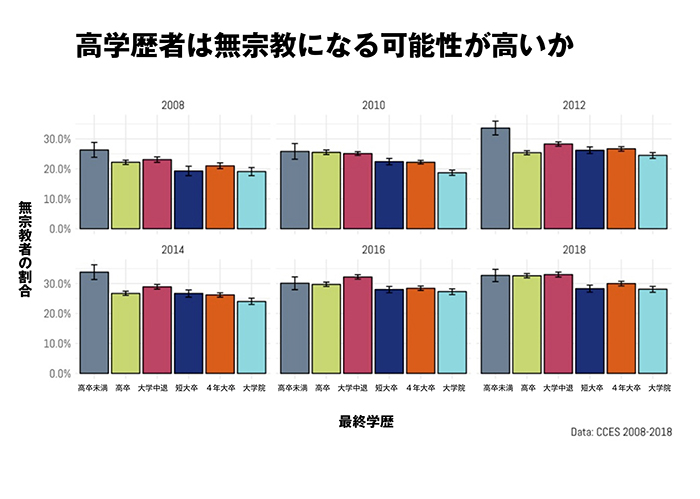大学で宗教社会学を受講すれば、教授は必然的に「世俗化理論」として知られる講義に時間を費やすだろう。つまり、社会が経済的に繁栄し、人々がより高いレベルの教育が受けられるようになると、その結果、人々は組織化された宗教から遠ざかり、世俗化へと向かうというのだ。
If you take a course in the sociology of religion at any college or university, the professor will inevitably spend some time on what is known as secularization theory. This theory posits that as societies become more economically prosperous and obtain higher levels of education, the inevitable result is a movement away from organized religion and toward secularization.
有名な精神科医ジークムント・フロイトは、宗教を子どものおとぎ話と比べるのが好きで、「社会が理性に焦点を合わせるようになるにつれ、宗教的信仰から離れていく」と信じていた。またカール・マルクスは、「支配階級によって庶民がいかに利用されたかを理解できないようにするための道具として宗教が使われている」と主張した。
The famous psychiatrist Sigmund Freud was fond of comparing religion to a child’s fairy tale and believed that as society becomes more focused on reason, it will drift away from religious faith. Karl Marx contended that religion was used as a tool to keep the masses from understanding how exploited they were by the ruling class.
マスクスが「宗教はアヘン」と書き記したことは有名だ。世俗化理論の結論によると、経済的・教育的進歩は現代文明の事実であり、宗教的信念が捨て去られることは避けられない。
Marx famously wrote that religion was “the opium of the people.” The logical conclusion of secularization theory is that economic and educational progress is a fact of modern civilization and therefore the inevitable outcome is a casting off of religious beliefs.
この主張を支持するためによく提供されるグラフは、以下のものと驚くほど似ている。横軸は経済的繁栄(国民一人当たりの国民総生産)、縦軸はその国の宗教の全体的レベルを表す。
The graph that is often offered to bolster this claim looks strikingly similar to the one below. The horizontal axis provides a good proxy for economic prosperity (gross national product per capita), while the vertical axis represents the overall level of religiosity in a nation.
このグラフからの結論は明らかだ。経済的に繁栄する国ほど、「宗教が非常に重要」と言う国民が少なくなる。ただし、いくつかの異常値がある。中国は、グラフの左下に位置している。つまり、その国の経済生産高に基づけば、もっと宗教的であるべきなのだ。また、ハンガリーについても同じことが言える。
The conclusion from this graph is clear: the more economic prosperity a nation enjoys, the fewer citizens of that country say that religion is very important. There are a few outliers, however. China is in the bottom left portion of the graph, which means that based on the country’s economic output it should be more religious than it currently is, with the same occurring in Hungary.
明らかに両国は、共産主義と密接に関連する歴史を持っており、それが宗教性が低い原因と考えられる。一方、米国も明らかに異常値だ。グラフの中で最も経済的に繁栄している国にランクづけされているから、宗教的レベルはゼロに近いはずなのに、実際はトレンド・ラインの真ん中に位置している。
Obviously, both of those countries have a history that is closely associated with communism, which is the likely cause of their low levels of religiosity. On the other hand, the United States is clearly an outlier on this graph. It ranks as the most economically prosperous country in the dataset, but if it were going to be in the middle of the trend line, the overall level of religiosity should be very close to zero.

米国人の半数以上が「宗教が非常に重要」と考えている。この角度から見ると、米国は世俗化傾向に明らかに抵抗している。
Instead, just over half of Americans think that religion is very important. The United States clearly bucks the trend of secularization when looked at from this angle.
ここから二つの見解が考えられる。まず、米国には世俗化の波が少し遅れてやって来るというもの。あるいは、どういうわけか他国とは異なり、米国だけが世俗化の例外となっているというものだ。米国の宗教的行動に関する最近のデータは、実際に起こっていることを理解するのに役立つだろう。
There are two possible thoughts that emerge from this. One is that secularization is coming to the United States, it’s just moving a little slower. The other is that somehow the U.S. is different and is the exception to secularization. Recent data on America’s religious behaviors can help us understand what is really occurring.
米国人の調査に目を向ければ、教育と宗教の関係を理解するのにも役立つ。下の棒グラフは、宗教が「ない」(無神論、不可知論、特になし)とされる各教育グループの割合を示している。
Turning to surveys of Americans can be helpful in understanding the relationship between education and religiosity. The bar graph below displays the percentage of each educational group that identifies as a religious “none” (atheist, agnostic, or nothing in particular).

教育的な達成は、経済繁栄の非常によい代理変数として用いられ、世俗化理論の確かな分析を提供する。CCES(共同議会選挙研究、Cooperative Congressional Election Study)調査の6つのグラフそれぞれに、3万人から6万5000人の回答者が含まれていることに注目しよう。
Educational attainment serves as a very good proxy for economic prosperity and provides a solid test of secularization theory. Note that each of the six waves of the Cooperative Congressional Election Study contain between 30,000 and 65,000 respondents.
その結果は明白で、教育水準が低い人は一貫して宗教的に無縁と識別される。 グラフのいちばん右のバーは、大学院レベルの教育を受けた人々で、ほとんどの場合、宗教に関わっていると識別される。
The results are unambiguous: those with the least amount of education are consistently the most likely to identify as religiously unaffiliated. The far right bar in the graph, indicating those with a graduate level education are almost always the group that is the most likely to be religiously affiliated.
「高学歴が世俗化に関連している」と主張したいのであれば、その結論を裏づける証拠はここには見当たらない。(後編に続く)
If one would like to argue that education is related to secularization, there is no evidence to support that conclusion to be found here.
「クリスチャニティー・トゥデイ」(Christianity Today)は、1956年に伝道者ビリー・グラハムと編集長カール・ヘンリーにより創刊された、クリスチャンのための定期刊行物。96年、ウェブサイトが開設されて記事掲載が始められた。雑誌は今、500万以上のクリスチャン指導者に毎月届けられ、オンラインの購読者は1000万に上る。
関連




























